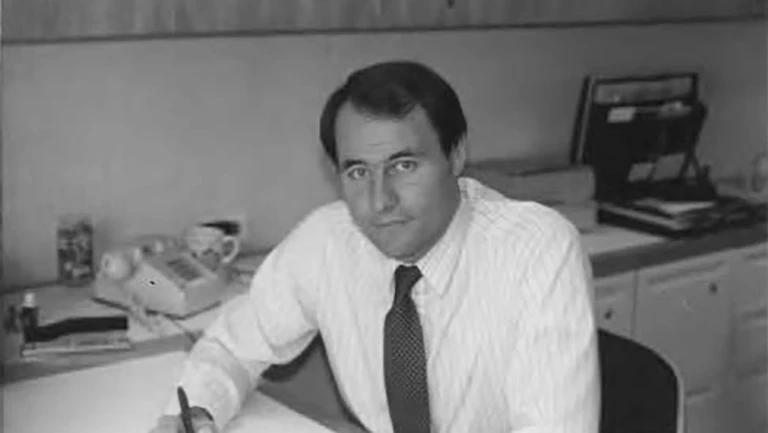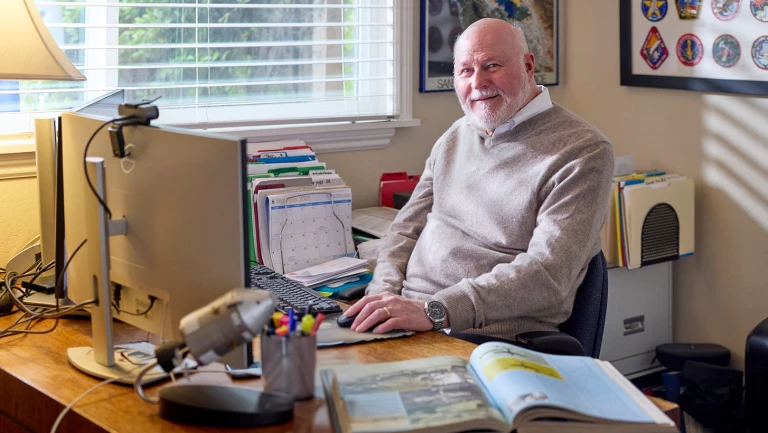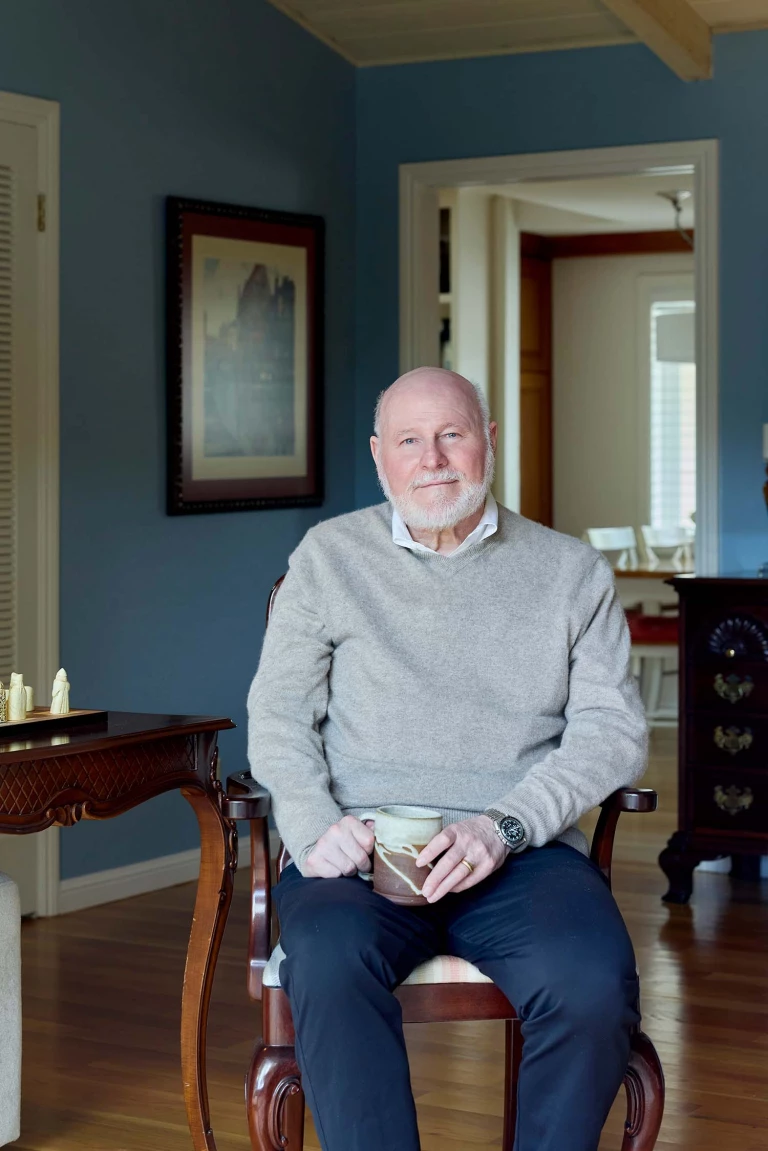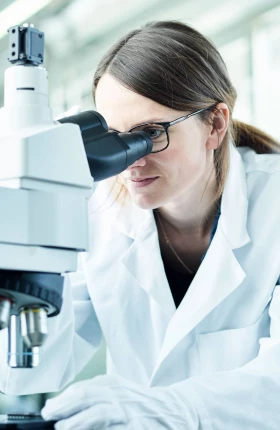As president and founder of the Myelin Repair Foundation, Scott Johnson is spearheading efforts to develop the first treatments that could potentially benefit millions of people by reversing and repairing nerve damage caused by multiple sclerosis.
The year was 2001 when Scott Johnson read a magazine article that changed his life. It was a brief story in Businessweek that discussed the idea of repairing the damage caused by multiple sclerosis (MS). At that point, Scott had been living with MS for 27 years, and he had never heard anyone talk about fixing and reversing the damage that MS does to the body’s neurological system, particularly the myelin that coats the nerves.
“You can think of myelin as the equivalent to the plastic insulation on a copper electrical wire,” explains Scott. “You need that insulation for two reasons. First, insulated nerves are able to transmit signals much faster. Second, if the myelin gets damaged, the underlying nerve will gradually degenerate and die.”
With MS, for some unknown reason, the body’s immune system starts attacking its own myelin, causing damage in the brain and spinal cord. Depending on the specific sites of the damage, MS creates multiple sensory issues, motor issues, and/or cognitive problems. For example, many people with MS, including Scott, experience heat sensitivity. “If I’m out in hot weather for very long, I just won’t be able to move. The heat will literally shut me down,” says Scott. “I have to stay cool so that the signals can keep running on the damaged nerves that I have. That shows how myelin is so essential.”
Since MS is an autoimmune disease, Scott says that research over the prior 50 years was focused mainly on tamping down the immune system to prevent or reduce myelin damage. Using some of the skills he’d picked up as a BCG consultant in the 1980s, Scott tracked down the scientists referenced in the Businessweek article and quizzed them about their research. He learned that not many people had focused on myelin repair before because the idea of repairing the brain with a therapeutic was considered to be science fiction. In short, it had never been done before.
The more he learned about the medical research ecosystem, however, the more that Scott was convinced that he could find a faster and more efficient way to drive MS research. After working at BCG, Scott had accumulated myriad business experiences—working at a large corporation, starting up a joint venture, leading a portfolio company for a VC. “I decided to apply my business and startup experience to attack the challenge in an entirely different way,” asserts Scott.
Gathering some of his core contacts, including a good friend from his BCG days, Scott formed a business advisory board that met monthly in the San Francisco Bay Area where he lives. This board helped him lay the groundwork for what would become the Myelin Repair Foundation (MRF), a nonprofit that Scott incorporated in 2002 with the singular goal of making myelin repair a reality and giving new hope to the millions of people worldwide living with MS.

Building Teams of Advisors and Collaborators
Scott found that academic researchers must focus on extremely narrow specialties in order to produce work that is truly cutting edge and more likely to get published. Furthermore, since their main capital as academics was their ideas, they tended to keep their research to themselves until it had been published, at which point other researchers could then build on those findings. This made progress too sequential and slow for Scott’s liking.
MRF took a completely different approach by creating a model they called ARC—Accelerated Research Collaboration™. “We knew that myelin repair was a really complex problem that would require the coordination and cooperation of different specialists who don’t normally interact,” he says. “The first thing we did was to figure out what expertise we needed and then identify the people we felt were the best scientists in the world in those areas. Then we approached them and offered to fund them—but only if they worked collaboratively with MRF and other scientists to create and execute a research plan.”
To coordinate the research, MRF pulled together a staff of senior pharma scientists and a scientific advisory board. “The cool thing here is that because we had identified brilliant scientists, we were able to attract equally brilliant staff and advisors,” notes Scott.
Once MRF’s scientists began to make promising basic discoveries on myelin repair, Scott enlisted BCG’s help to perform a pro bono case study that helped MRF figure out how to start commercializing this research.
The BCG study helped MRF determine that the best way to validate its researchers’ discoveries was to set up a translational medicine center that would commercialize assays and test compounds. At the same time, MRF set up two more advisory boards: a drug discovery advisory board with experts from the pharma industry who could provide guidance on which academic discoveries to move forward, plus a clinical advisory board to help configure what would become the very first clinical trials on myelin repair.
From a leadership perspective, MRF turned out to be quite different from any of Scott’s earlier executive roles. “At one point, we were funding about 50 scientists, none of whom were our employees or wanted to be managed. Instead of the command-and-control structure that might work in the business world, I had to rely more on convincing them that we provided enough value to compensate for any annoyance they experienced from being managed,” he reflects. “For example, if one of our researchers had trouble buying a piece of equipment, we would buy it for them. Unlike other grants they received, we encouraged rapid changes in scientific direction as new discoveries were made. We would also have students from one lab we were funding go into other labs to pick up new techniques and bring them back.”
Scott notes that the academic researchers who worked with MRF benefitted in other ways. They reported publishing at a faster rate, designing better experiments, and attracting more top students to their labs thanks to the collaborative elements of the ARC™ model. These benefits created a virtuous cycle that helped reinforce the researchers’ interest in continuing to engage with MRF.

From $80 Million in Donations to Billions in Research Investments
Academic medical discoveries only interest Scott if they turn into commercial treatments. “As a patient and a patient advocate, I want to make sure these discoveries have real-world benefits,” he says.
That’s why he measures MRF’s success in terms of the impact the organization has had on drug development efforts focused on myelin repair. “When we started, there were no pharma companies interested in investing in myelin repair,” reveals Scott. “After 10 or 12 years of MRF’s work in this area, myelin repair became known as the next generation of MS treatment after immune suppression drugs.”
Today, Scott says that more than 30 companies have myelin repair drug development efforts underway. “We estimate that these companies are probably spending about $2.5 billion per year on drug development,” remarks Scott. “Considering that our entire expenditures over the past 23 years have been about $80 million, I’m really proud of the fact that we’ve been able to generate this interest and jump-start broader funding for myelin repair research.”
Going All In on Biomarkers
In 2016, Scott reached out to his contacts at the NIH and the pharma sector to ask how MRF could be most helpful in getting these drug candidates that were in development across the finish line and win FDA approval. He learned that the pharma researchers needed a biomarker that would clearly indicate whether a compound being investigated did in fact stimulate myelin repair.
“In cancer research, you can take a biopsy of a tumor to see how it’s responding to a treatment, but that approach doesn’t work for MS or other neurological research because you can’t biopsy a brain until someone is dead,” explains Scott. “If we had a low-cost, non-invasive indicator that showed whether a drug is causing myelin repair, that would greatly accelerate progress toward FDA approval.”
At that point, MRF narrowed its focus and began concentrating on developing just such a biomarker, setting its sights on an emerging area of research called extracellular vesicles or EVs. Much like an email exchange, EVs contain messages that cells send to each other to communicate their status and needs. By analyzing blood samples, MRF-funded researchers found that they could identify the EVs emitted by brain cells and decode the messages being sent. “We think of it as a liquid biopsy,” notes Scott.
Scott says that, after eight years of research, MRF has developed an assay that not only shows a clear signal between healthy control subjects and people with MS, but also can detect the presence of other neurological diseases such as Parkinson’s. He’s hopeful that such biomarkers could accelerate efforts to find effective treatments for other neurological diseases in addition to MS.

Questioning the Status Quo
Today, Scott thinks MRF is about 18 months away from having a biomarker that pharma companies can use to test their MS drug candidates. He’s convinced that the first myelin repair drugs are likely to reach the market no later than 2029. “It might sound horrible, since we started funding this research in 2004, but historically it’s taken about 50 years from a discovery in an academic lab to get FDA approval,” declares Scott. “When we launched our nonprofit, the initial discovery had not even been made. We had to fund the work to make some of those breakthroughs, which means we will have cut the time from breakthrough to approval by more than half through our accelerated research collaboration model.”
When asked what it takes to be an innovative leader, Scott says that you have to be willing to challenge the status quo. Looking back, he credits MRF’s success to the fact that he applied a business startup approach, set a clear goal, had metrics to measure progress toward that goal, and assembled a small team of the best people. “Great people want to work with other exceptionally talented people to attack the most difficult problems,” he asserts. “It’s also important for leaders to be flexible and view challenges that seem like impediments as opportunities to come up with some new approach.”
As MRF continues to raise donations to complete its biomarker effort, Scott will be donating his $5,000 BCG Alumni Award prize to MRF, where it will go help fund one of the scientists researching ways to make the myelin repair biomarkers better, faster, and more affordable.
Reflecting on MRF’s other funders, Scott notes that half the money the organization has raised over the years has come from people with no ties to the MS community. “They wanted to see if we could prove the benefits of the ARC™ approach,” he says. “Even though we were focused on myelin repair from day one, we also wanted to show that you could speed up scientific progress if you did things differently, and that’s what we’ve done.”












